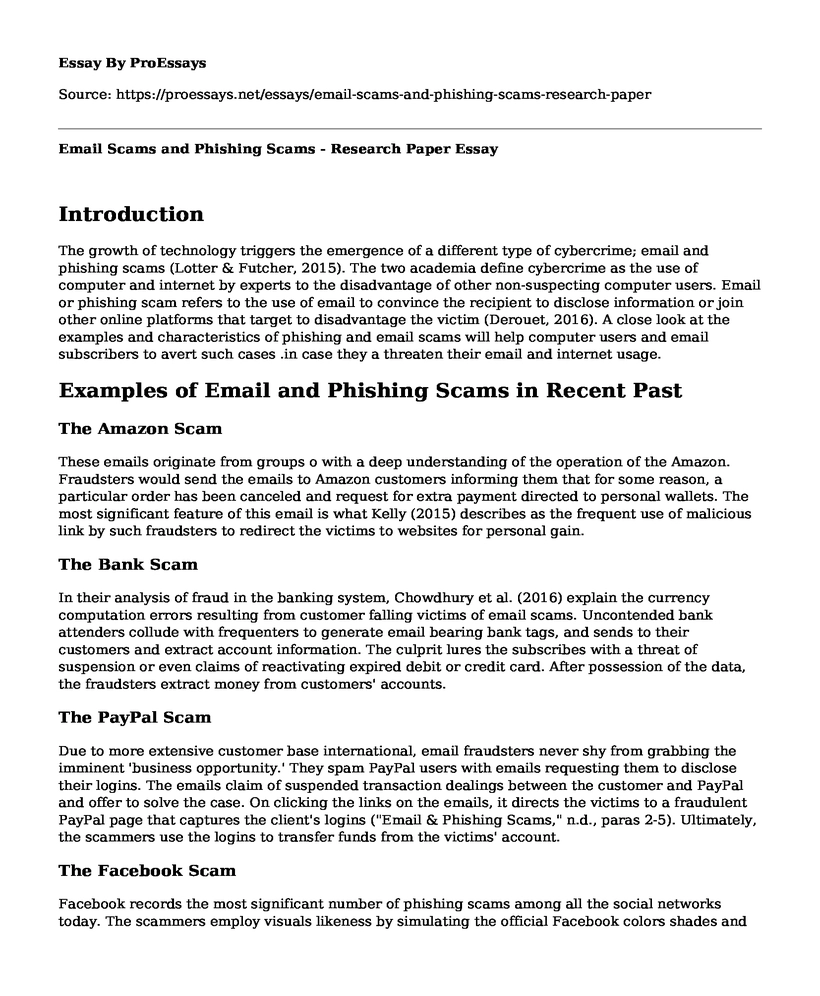Introduction
The growth of technology triggers the emergence of a different type of cybercrime; email and phishing scams (Lotter & Futcher, 2015). The two academia define cybercrime as the use of computer and internet by experts to the disadvantage of other non-suspecting computer users. Email or phishing scam refers to the use of email to convince the recipient to disclose information or join other online platforms that target to disadvantage the victim (Derouet, 2016). A close look at the examples and characteristics of phishing and email scams will help computer users and email subscribers to avert such cases .in case they a threaten their email and internet usage.
Examples of Email and Phishing Scams in Recent Past
The Amazon Scam
These emails originate from groups o with a deep understanding of the operation of the Amazon. Fraudsters would send the emails to Amazon customers informing them that for some reason, a particular order has been canceled and request for extra payment directed to personal wallets. The most significant feature of this email is what Kelly (2015) describes as the frequent use of malicious link by such fraudsters to redirect the victims to websites for personal gain.
The Bank Scam
In their analysis of fraud in the banking system, Chowdhury et al. (2016) explain the currency computation errors resulting from customer falling victims of email scams. Uncontended bank attenders collude with frequenters to generate email bearing bank tags, and sends to their customers and extract account information. The culprit lures the subscribes with a threat of suspension or even claims of reactivating expired debit or credit card. After possession of the data, the fraudsters extract money from customers' accounts.
The PayPal Scam
Due to more extensive customer base international, email fraudsters never shy from grabbing the imminent 'business opportunity.' They spam PayPal users with emails requesting them to disclose their logins. The emails claim of suspended transaction dealings between the customer and PayPal and offer to solve the case. On clicking the links on the emails, it directs the victims to a fraudulent PayPal page that captures the client's logins ("Email & Phishing Scams," n.d., paras 2-5). Ultimately, the scammers use the logins to transfer funds from the victims' account.
The Facebook Scam
Facebook records the most significant number of phishing scams among all the social networks today. The scammers employ visuals likeness by simulating the official Facebook colors shades and arrangement. On clicking the links, they direct to purchasing sites.
Similarities Between Email or Phishing scams
Regardless of the industry, the manner in which scammers victimize company subscribers follow the same trend. In a Phishing and Scams. (n.d) Encyclopedia, there exist a clear highlight of these similarities, the dominant one being the use of links as in Amazon and PayPal case, and redirect from the initial browsing page as the case of Facebook. Whether it is through the redirects, malicious links or plain fraud emails, the three exhibit another similarity which is the target to the acquisition of victim's personal information. With such information, the culprits end up siphoning funds from the victims (Dunn & Hanrahan, 2018).
Conclusion
Email and Phishing scams are a common form of internet communication crime and end up harming subscribers to different companies financially. To prevent such cases, email subscribers should note that legit companies never ask for confidential information from their subscribers and desist from giving personal information to such groups, and company administrators should undertake cybersecurity consciousness training and employ anti-phishing tools.
References
Chowdhury, M. U., Abawajy, J. H., Kelarev, A. V., & Hochin, T. (2016). Multilayer hybrid strategy for phishing email zero-day filtering. Concurrency and Computation: Practice and Experience,29(23). doi:10.1002/cpe.3929
Derouet, E. (2016). Fighting to phish and securing data with email authentication. Computer Fraud & Security,2016(10), 5-8. doi:10.1016/s1361-3723(16)30079-3
Dunn, A., & Hanrahan, M. (2018). Internet Scams. Reservoir, VIC: Preston Reservoir Adult Community Education.
Email & Phishing Scams. (n.d.). Retrieved from https://protect.iu.edu/online-safety/personal-preparedness/email-phishing.html
Kelly, J. (2015). Dear Beneficiary. London: Cutting Edge Press.
Lotter, A., & Futcher, L. (2015). A framework to assist email users in the identification of phishing attacks. Information and Computer Security,23(4), 370-381. doi:10.1108/ics-10-2014-0070
Phishing and Scams. (n.d.). The SAGE Encyclopedia of Surveillance, Security, and Privacy. doi:10.4135/9781483359922.n331
Cite this page
Email Scams and Phishing Scams - Research Paper . (2022, Nov 14). Retrieved from https://proessays.net/essays/email-scams-and-phishing-scams-research-paper
If you are the original author of this essay and no longer wish to have it published on the ProEssays website, please click below to request its removal:
- Personal Feedback to Videos
- The Rise of Internet News Has Crippled the Print Media: Paper Example
- Essay Sample on Serial Killers: Chilling Statistics From Public Records
- Essay on Creating a Recovery Plan: Hardware & Data Backup Solutions
- Essay Sample on Power of the Internet: Improving Business Operations and Strategies
- Essay Example on DHS Established: Securing US Nation After 9/11 Attacks
- The Essential Role of IT Security in Contemporary Society - Essay Sample







